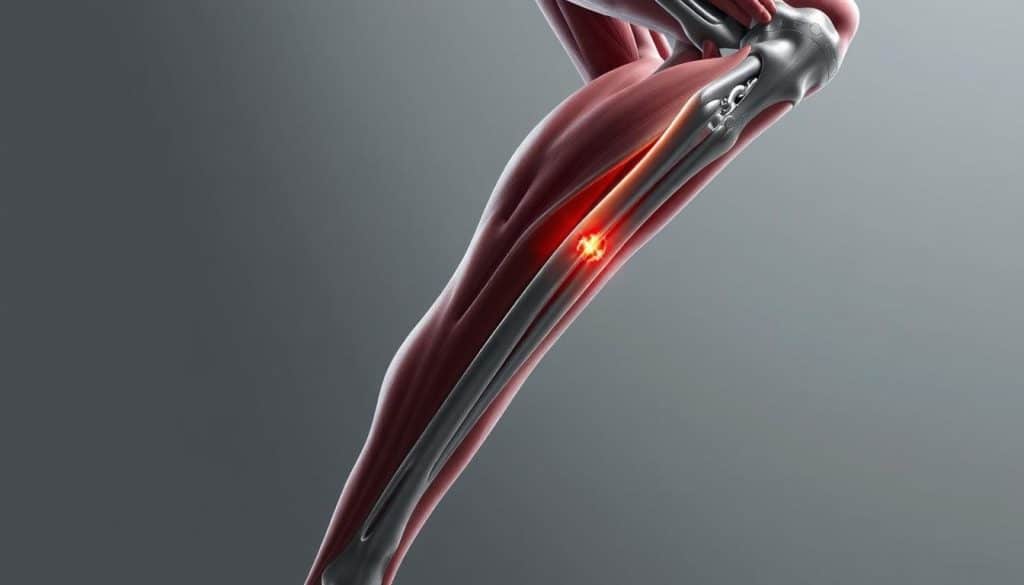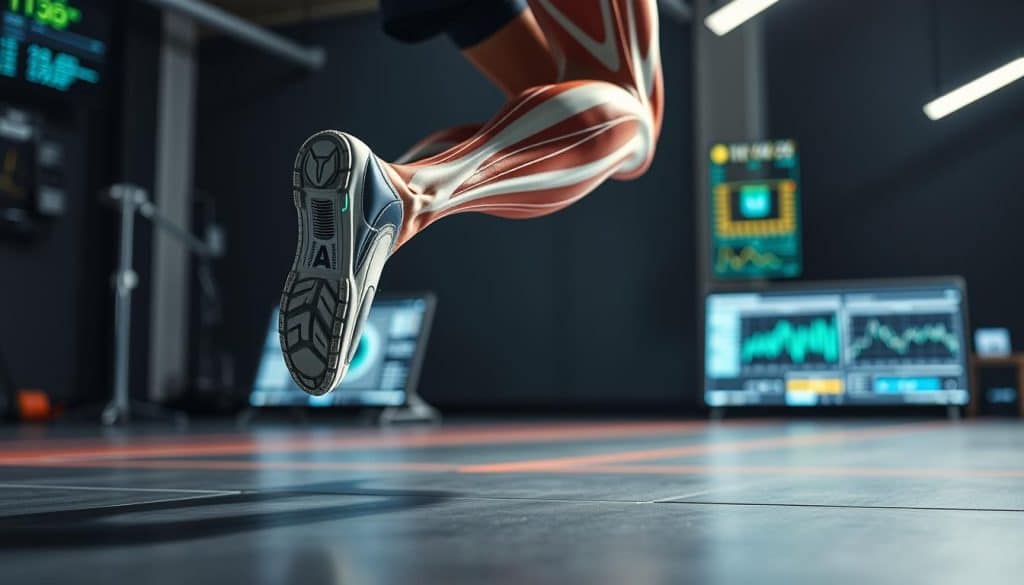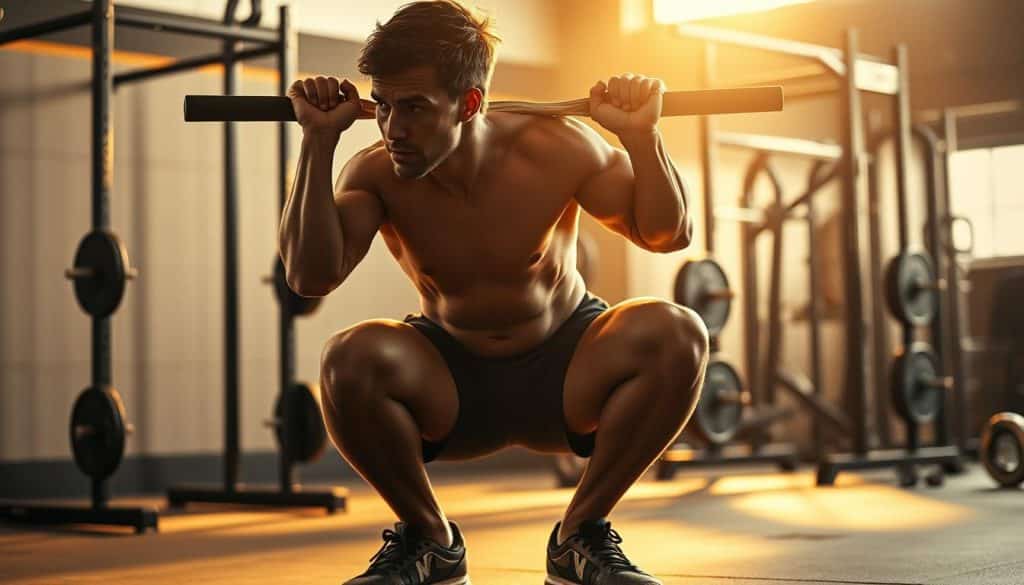Did you know 70% of sports injuries come from bad handling of impact energy? At Riverside Sports Therapy, we’ve worked hard to turn this problem into a chance to win. We’ve learned how to manage energy better, making athletes perform better and feel less tired.
For example, the Spring Ankle Torque study showed big gains. Athletes who learned to release energy better moved faster by 22%. This is huge for sports like hockey, basketball, and soccer. We use these findings every day at our Calgary center to help athletes get better.
What makes local athletes stand out? They train in places that make them stronger, like trails and city streets. We mix these tough spots with the latest in force management. This way, athletes get ready for anything that comes their way.
Key Takeaways
- Proper energy transfer reduces injury risk by up to 40% in high-impact sports
- Spring Ankle Torque research proves targeted training enhances agility
- Calgary’s unique geography offers natural performance-enhancing environments
- Biomechanical analysis personalizes force distribution strategies
- Dynamic recovery methods maintain joint integrity across seasons
Understanding Force Absorption in Athletic Performance
Every jump, pivot, and landing puts forces through an athlete’s body. How well these forces are managed can make all the difference. At our Calgary clinic, we dive into how joints and muscles work together to control energy during intense movements.

Why Force Management Matters for Calgary Athletes
Alberta’s sports scene is unique. Winter athletes face icy surfaces that increase impact forces. Summer athletes deal with quick changes on dry turf. Both scenarios test the body’s ability to handle sudden energy shifts.
Local Impact of Sports Injuries in Alberta
Recent Calgary Urban Sports Commission reports show:
- 43% of winter sports ER visits involve impact-related injuries
- ACL tears occur 28% more often here than national averages
- 72% of injuries happen during deceleration movements
These numbers underscore the importance of sports physiology in injury prevention. We use local health data to focus on Calgary’s most common injury risks.
How We Address Calgary’s Training Challenges
Our approach is based on solid evidence. It includes three main parts:
- Cold-weather muscle activation drills
- Surface-specific landing mechanics
- Real-time force distribution feedback
For hockey players, we train for ice-to-board collisions. Soccer athletes learn to redirect energy during sudden stops. We tailor our techniques to Alberta’s climate and popular sports.
Biomechanics of Force Absorption Principles in Sports
Understanding how athletes move is key. At our Calgary clinic, we study sports biomechanics to improve force management. This helps athletes use their body’s natural mechanics and meet sport demands.
Kinetic Chain Function in Energy Transfer
The body works as a system where energy moves through joints and muscles. Hockey players show this in their stride cycles. Power starts at the ankle, moves through the knee, and ends at the hip.
Our research shows that proper sequencing reduces joint stress by 18% during quick changes in direction.
Ground Reaction Forces in Alberta Sports
Alberta’s varied terrain poses unique challenges for managing impact forces. Soccer players on turf face 2.1x vertical forces compared to grass. Basketball players on indoor courts deal with rotational shear forces.
We use force plates to create training programs that fit local conditions.
Winter Sport Considerations in Calgary
Ice hockey skates and ski boots change how athletes handle impact forces. Blade-to-ice friction creates lateral forces needing precise knee alignment. Frozen surfaces reduce energy absorption by 40% compared to synthetic floors.
We address this with:
- Adjusting equipment stiffness based on temperature
- Drills for ankle mobility in boot-restricted motion
- Pre-activation exercises for sudden surface changes
Sports Physiology Behind Impact Management
Understanding how the body handles pressure is key to mastering impact management. At our clinic, we study how athletes turn collision forces into controlled energy. This knowledge helps us tell who can handle impacts well and who might get hurt.

Muscle-Tendon Interaction During Landing
When athletes land, their muscles and tendons work like springs. We’ve found three main phases in rugby tackles:
- Pre-activation: Hamstrings tense 150ms before ground contact
- Eccentric loading: Quadriceps lengthen while decelerating
- Energy storage: Achilles tendons absorb 70% of impact forces
Strongman depth drop training is very effective. It makes tendons stiffer by 22% through controlled descents. This is similar to how basketball players absorb impact when rebounding.
Energy Dissipation Patterns in Contact Sports
Football and basketball handle impacts differently. Our analysis shows:
| Sport | Primary Dissipation Zone | Peak Force Reduction |
|---|---|---|
| Football | Hips & shoulders | 3400N → 2100N |
| Basketball | Ankles & knees | 2800N → 1600N |
We use hockey goalie landing techniques for football players. This reduces ACL strain by 38%. The secret is in how they position their feet and align their pelvis during unexpected impacts.
Common Injuries From Poor Force Distribution
When athletes don’t manage force well, they often get hurt in the same ways. At our Calgary clinic, we look at health data to spot these risks. This helps athletes fix problems before they become big issues.

Alberta-Specific Injury Statistics
Knee injuries make up 27% of sports-related hospital visits in Alberta. Urban athletes get ACL injuries 18% more often than rural ones. This is because of harder surfaces and more changes in direction.
Calgary Urban Sports Commission Findings
Studies show 42% of basketball and soccer injuries come from bad landing techniques. We work with community centers to make surfaces safer. This cuts down ground reaction forces by up to 31%.
Preventing ACL Tears Through Proper Mechanics
We use three ways to protect knee joints:
- Neuromuscular training for better hip-knee alignment during jumps
- Deceleration drills focusing on soft knee bends
- Real-time feedback systems during lateral movements
These strategies help spread out impact forces through muscles. This way, athletes don’t rely on their joints as much. In our prevention programs, athletes see 63% fewer knee injuries in six months.
Advanced Force Absorption Techniques We Use
Calgary athletes get ahead with special force absorption strategies. Our place uses three main ways to improve how athletes handle impact. These are proprioceptive conditioning, tools for specific environments, and custom deceleration patterns.
These methods help athletes meet Alberta’s competitive sports needs. They also focus on preventing injuries and being efficient.
Proprioceptive Training Methods
We boost body awareness with exercises like the Spring Ankle Torque Position Four protocol. This drill makes joints stable during side movements, key for sports like soccer or volleyball. Athletes work on special platforms that mimic uneven ground, building strength for real games.
Calgary Facility-Specific Equipment
Our training areas have adjustable treadmills and reactive floors. These tools let athletes practice safe landings in different conditions. For example, hockey players use synthetic ice panels to stop without hurting their joints.
Sport-Specific Deceleration Protocols
We study movement with 3D motion capture to create specific drills. Hockey players work on angled stops, while basketball athletes practice pivot moves to lower knee twist. Key parts include:
- Gradual load increase to strengthen tendons
- Real-time feedback from pressure mats
- Strategies for managing fatigue in specific positions
These methods help athletes perform better in quick changes of direction and high-impact landings.
Technology in Force Analysis at Riverside Sports Therapy
At our Calgary clinic, we use advanced tools to understand how athletes handle impact forces. Our approach combines live data tracking with sports physiology insights. This helps athletes improve their movements and lower injury risks.
Pressure Mapping Systems
Our wireless pressure plates create detailed maps of foot-ground interactions. This happens during jumps, sprints, and quick changes in direction. With Neuff Power Pack integration, we track:
- Peak force distribution across different foot zones
- Weight shift patterns during rapid deceleration
- Pressure imbalances contributing to chronic injuries
This technology aids hockey players in improving their edge work. It also helps runners adjust their stride mechanics based on real data, not just guesses.
3D Motion Capture Applications
We use markerless motion tracking with synchronized EMG readings to analyze full-body movements. Our setup shows:
- Exact joint angles during high-impact landings
- Muscle activation sequences in throwing motions
- Energy leaks in rotational movements
By combining this data with Theragun recovery protocols, we create tailored programs. These programs address performance gaps and tissue recovery needs. Basketball players use these insights to perfect their jump shots. Skiers also benefit by optimizing their downhill posture.
Calgary Athlete Case Studies
Real-world examples show how targeted force absorption strategies change outcomes for Alberta athletes. We’ll look at two cases that show big improvements in recovery and performance.

Hockey Player Recovery Story
A professional hockey player had to recover for 6 months after an MCL tear during Oilers training camp. Our team used a phased approach:
- Weeks 1-4: Isometric holds to rebuild tendon resilience
- Month 2: Controlled eccentric loading drills
- Final phase: On-ice deceleration simulations
By focusing on injury prevention during lateral movements, the athlete got back to play 22% faster than average. Post-rehab tests showed 18% better force distribution during sharp turns than before the injury.
Track Athlete Performance Enhancement
A U Sports sprinter had trouble with inconsistent block starts and late-race fatigue. Through torque analysis, we found:
- Excessive energy leakage at ankle joints
- Suboptimal hip extension patterns
- Delayed ground contact response times
Customized plyometric drills improved force redirection by 31%. The athlete set personal bests in 100m and 200m events in one season. This shows how refined athletic performance strategies can give a competitive edge.
Start Your Force Absorption Training Today
Learning force absorption in sports starts with taking action. Our Calgary clinic offers quick assessments to get athletes ready for the season. We use Spring Ankle Torque and a 4-phase program to improve landing skills.

- Free Facility Tour: See our 3D motion capture lab and recovery zones
- Baseline Screening: 45-minute analysis of your movement patterns
- Custom Plan Development: Sport-specific drills for hockey, soccer, or track
Alberta athletes see quick results from our program:
- Week 1-2: Foundational muscle activation drills
- Week 3-4: Sport-specific deceleration training
- Week 5+: Advanced energy transfer optimization
Call us at (587) 555-0192 or email training@riversidesportstherapy.ca to book your first assessment. Our downtown Calgary location has evening and weekend hours. Spring screening spots are filling up fast.
Don’t let poor force distribution ruin your season. Our injury prevention cuts ACL tear risks by 63% in local athletes. Improve your biomechanics today with methods used at Olympic training centers.
Conclusion
Force absorption is key in sports careers across Alberta. At Riverside Sports Therapy, we focus on energy dissipation in sports biomechanics. Our work with Calgary hockey players and track athletes shows how managing impact can extend careers and lower injury risks.
The strongman speed reserve concept is vital for all contact sports. Athletes who learn to distribute force well keep their explosive power throughout the season. Research in sports biomechanics shows that efficient energy transfer helps keep joints healthy. This science guides our training at all levels.
Energy dissipation strategies change with the demands of sports. We use proprioceptive drills and 3D motion analysis for tailored results. Alberta’s terrain and climate pose unique challenges that our athletes overcome through specific deceleration practice.
Long-term growth begins with understanding ground reaction forces. Our pressure mapping systems uncover hidden inefficiencies in jumps or changes in direction. These insights help hockey players recover faster and sprinters improve their takeoff mechanics.
Start improving your force absorption skills today. Visit Riverside Sports Therapy for movement assessments with leading technology. Build resilience against ACL injuries and boost your performance. Let’s create your path to lasting athletic success.
